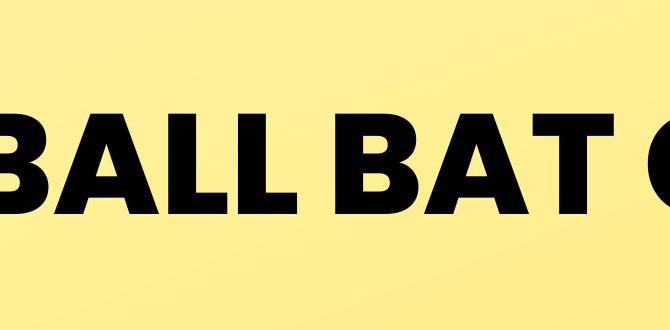Quick Summary:
Choosing the right catcher’s shin guards is vital for protection and comfort. This guide compares key features like material, coverage, and adjustability to help beginners pick the best pair for their play style and budget, ensuring they stay protected behind the plate.
Hey batters, catchers, and parents! John P. Miller here, bringing you another guide straight from FriskMode to help you step up your game. Today, we’re diving deep into a piece of gear that’s just as crucial as your glove: catcher’s shin guards. If you’ve ever felt the sting of a foul tip or worried about taking a direct hit, you know how important good protection is. We’ll break down what makes one pair better than another, keeping things super simple so you can make a smart choice without the headache. Let’s get those legs protected!
Choosing the Right Catcher’s Shin Guards: Your Essential Guide
As John P. Miller of FriskMode, I know that stepping behind the plate is a serious job. You’re the leader, the strategist, and the protector of home plate. And to do that job well, you need the right gear. Among the most critical pieces of equipment are your catcher’s shin guards. They’re your first line of defense against errant pitches, foul balls, and those unavoidable collisions. For beginners and intermediate players, understanding the differences between various shin guards can feel overwhelming. But don’t worry! This guide is designed to cut through the noise, offering a clear, easy-to-understand comparison to help you find the perfect pair.
We’ll look at what makes shin guards effective, what to consider when buying, and how different styles stack up. My goal is to empower you with the knowledge to make an informed decision, ensuring your agility, comfort, and most importantly, your safety. Let’s get started on finding the shin guards that will keep you feeling confident and protected throughout every inning.
Why Catcher’s Shin Guards Are Non-Negotiable
Think of your shin guards as your armor. Behind the plate, you’re often in a vulnerable position. Pitches can bounce unexpectedly, foul tips can come flying towards your legs, and there’s always the possibility of a runner sliding hard. Shin guards are specifically designed to absorb impact and prevent serious injuries to your knees, shins, and feet. For young players especially, developing good habits and using proper protective equipment from the start is paramount in preventing long-term issues and fostering a love for continued play.
Key Features to Consider in Catcher’s Shin Guards
When you’re scouting for the perfect pair of shin guards, a few key aspects will make the biggest difference:
- Protection Level: This refers to the thickness and density of the padding, as well as the overall coverage of the guard. More padding generally means better protection but can sometimes affect mobility.
- Material: Shin guards are typically made from a combination of plastic (for the outer shell) and foam or other padding materials on the inside. The quality of these materials impacts durability, comfort, and protection.
- Fit and Size: Shin guards come in various sizes, often categorized by age group or leg length. A proper fit is crucial for both protection and comfort. They should feel snug but not constricting.
- Coverage Area: Some guards offer more coverage than others, extending higher up the thigh or further down the foot. Consider your specific needs and playing style.
- Ventilation: Baseball can be a hot sport! Good ventilation helps keep your legs cooler and more comfortable during long games and practices.
- Straps and Adjustability: The way shin guards attach to your legs matters. Secure, adjustable straps ensure a custom fit and prevent the guards from shifting during play.
- Weight: While protection is key, overly heavy shin guards can hinder your speed and agility. Finding a balance is important.
Types of Catcher’s Shin Guards
Catcher’s shin guards generally fall into a few broad categories, though many modern designs blend features from these:
1. Traditional Shin Guards
These are the most common and widely used type. They typically feature a hard plastic shell designed to cover your shins and knees, with straps to secure them in place. The padding inside varies greatly, offering different levels of impact absorption. They are generally durable and provide reliable protection for most players.
2. Extended Coverage Shin Guards
As the name suggests, these offer more protection than standard models. They often extend higher up to cover more of the thigh area and may also provide more substantial protection for the top of the foot. These are a great option for catchers who want that extra layer of security, especially in youth leagues where balls might be a bit wilder.
3. Lightweight/Low-Profile Shin Guards
For players who prioritize speed and agility, these guards are designed to be lighter and less bulky. While they might offer slightly less padding than their more substantial counterparts, they still provide adequate protection for many players and can improve freedom of movement. They are often favored by players who also play other positions or prefer a sleeker feel.
4. Catcher’s Leg Guards (Often a Set)
Sometimes, the term “catcher’s leg guards” refers to a more comprehensive system that might include separate pieces for the shin and knee, or a connected unit. These can sometimes offer a more customizable fit, allowing players to adjust each part independently. However, they can also be more complex to put on and may have more potential for shifting if not fitted correctly.
Comparing Popular Shin Guard Features
Let’s break down some common material and design choices you’ll find when comparing catcher’s shin guards.
Outer Shell Materials
The primary material for the outer shell is almost always some form of hardened plastic. The differences lie in the plastic’s density, thickness, and how it’s molded.
- Polycarbonate: Known for its high impact resistance and durability. It can withstand significant force, making it ideal for the outer shell.
- ABS Plastic: Another common and robust plastic used for its strength and cost-effectiveness.
- Composite Materials: Higher-end models might use proprietary composite blends that offer excellent strength-to-weight ratios, meaning they are both strong and lighter.
Padding and Liner Materials
The interior padding is where comfort and shock absorption really come into play. Different foams and liners serve various purposes:
- High-Density Foam (EVA/Polyurethane): These are workhorses in shin guard padding. They offer good shock absorption and are relatively lightweight.
- Memory Foam: Some designs incorporate memory foam for a more custom, comfortable fit that molds to the player’s leg over time.
- Moisture-Wicking Liners: Crucial for comfort, especially in warm weather. These liners pull sweat away from the skin, helping to keep legs drier and reducing chafing.
- Removable Liners: Some guards feature liners that can be detached for easier cleaning, which is a massive plus for hygiene and extending the life of the gear.
Strap Systems
How the shin guards stay on your legs is critical. Secure straps mean reliable protection and comfort.
- Elastic Straps with Velcro: The most common type. They offer a good balance of security and adjustability. Look for wide, sturdy Velcro for a reliable hold.
- Buckle Straps: Some higher-end models use buckle systems, similar to those found on ski boots. These can offer a very secure and precise fit but might be slightly bulkier.
- Upper Thigh Straps: Guards that extend higher often have additional straps at the top to prevent slippage.
Shin Guard Sizing: Getting the Perfect Fit
Getting the right size is arguably the most important factor after the level of protection. Ill-fitting shin guards can be uncomfortable, slide down, or, worse, leave gaps where you need protection the most. Here’s how to generally approach sizing:
Sizing by Age Group
This is the most common method for youth players. Manufacturers typically offer sizes like:
- Youth (e.g., 7-10 years old)
- Intermediate/Junior (e.g., 10-13 years old)
- Senior/Adult (e.g., 14+ years old)
These are just general guidelines, and actual dimensions can vary between brands. Always check the specific size charts provided by the manufacturer.
Sizing by Leg Measurement
For a more accurate fit, manufacturers often provide measurements. The most common measurement is from the center of the kneecap down to the instep (where the tongue of your shoe sits).
How to Measure:
- Sit on a chair with your leg bent at a 90-degree angle.
- Place a ruler or measuring tape on your leg.
- Measure from the middle of your kneecap straight down to the point where your shoe’s tongue would typically rest on the top of your foot (the instep).
- Consult the brand’s sizing chart to find the corresponding shin guard size.
Tip: It’s often better to go slightly larger than slightly smaller. If a guard is a bit too long, the padding can still offer protection. If it’s too short, you’ll have unprotected areas.
Trying Them On
If possible, trying shin guards on before purchasing is ideal.:
- Wear your baseball pants and cleats (or similar athletic shoes) to get an accurate feel.
- Fasten the straps snugly.
- Walk around, bend your knees, and kneel. Do they stay in place? Are they comfortable?
- Check for any pinching or areas where the padding doesn’t align with your leg.
- Ensure there are no large gaps between the guard and your knee or foot.
Top Shin Guard Features for Different Player Needs
Not all players are the same, and their gear needs shouldn’t be either. Let’s look at what certain features are best for:
For the Budding Young Catcher (Youth Player)
- Prioritize: Excellent coverage, comfortable padding, ease of use (simple straps), and durability.
- Look For: Guards designed specifically for youth sizes, featuring a good balance of protection without being overly bulky. Removable liners and washable materials are a big plus for parents. Extended thigh coverage can be beneficial for added safety.
- Example Feature: A hinged knee design that allows for natural bending while maintaining protection.
For the Intermediate Player Looking to Improve
- Prioritize: Mobility, enhanced protection, adjustability, and ventilation.
- Look For: Shin guards that strike a balance between robust protection and freedom of movement. Features like breathable padding, well-designed strap systems for a secure fit, and good ankle coverage are important.
- Example Feature: Multi-piece designs that allow for independent movement of the knee cup and shin piece.
For the Serious Athlete / Advanced Player
- Prioritize: Lightweight design, superior impact dispersion, customizable fit, and maximum comfort for long games.
- Look For: Higher-end materials, advanced padding technologies, and ergonomic designs. These players often benefit from shin guards that feel like a natural extension of their body.
- Example Feature: Integrated toe protection and advanced internal padding structures designed to dissipate force.
For the Budget-Conscious Player
- Prioritize: Reliable protection for the cost, durability, and essential features.
- Look For: Well-regarded entry-level models. Often, slightly older models or those from reliable value brands can offer great performance without the premium price tag. Focus on solid construction and adequate padding.
- Example Feature: A well-constructed ABS plastic shell with good density foam padding and a dependable strap system.
Shin Guard Protection Standards and Certifications
While not as standardized as some other sports equipment, some manufacturers adhere to certain benchmarks for protective gear. For catcher’s shin guards, the primary concern is impact absorption. Organizations like ASTM International (American Society for Testing and Materials) create voluntary standards for various products, including sports equipment. Although there isn’t a universal “certification” for catcher’s shin guards in the same way there might be for helmets, reputable brands invest in research and development to ensure their gear meets high levels of protective performance. When evaluating, look for descriptions that mention:
- Impact-tested materials
- Engineered padding for shock absorption
- Durable shell construction
For more insight into general sports equipment safety standards, the ASTM International website is a valuable resource, though direct product certifications for shin guards specifically are less common than for items like helmets.
Maintenance and Care for Your Shin Guards
To get the most out of your catcher’s shin guards and keep them performing their best, proper care is key. It not only extends their lifespan but also keeps them hygienic.
General Cleaning Steps:
- Wipe Down the Exterior: After each use, especially after a sweaty game or practice, wipe down the plastic shell with a damp cloth. You can use mild soap and water if needed.
- Clean the Interior Padding: If the padding is removable, take it out and wash it according to the manufacturer’s instructions. This often involves hand-washing with a mild detergent and air-drying thoroughly. If the padding is not removable, use a damp cloth with a mild, odor-reducing spray (like a sports equipment deodorizer or a diluted vinegar solution). Be careful not to saturate the padding.
- Dry Thoroughly: This is crucial! Always allow shin guards to air dry completely. Never store them wet, as this can lead to mildew and unpleasant odors. Stuffing them with newspaper can help absorb moisture.
- Inspect Straps: Periodically check the straps and Velcro for wear and tear. Clean the Velcro to ensure it maintains a strong hold.
- Storage: Store your shin guards in a cool, dry place away from direct sunlight, which can degrade the plastic over time. Using a gear bag with good ventilation is recommended.
Proper care ensures your shin guards remain effective, comfortable, and odor-free, ready for your next game.
Catchers Shin Guards Comparison Table
To give you a quick overview of how different types of shin guards might stack up, here’s a simplified comparison. Remember that specific models within these categories will vary significantly.
| Feature | Traditional Shin Guards | Extended Coverage Shin Guards | Lightweight/Low-Profile Shin Guards |
|---|---|---|---|
| Protection Level | Good to Very Good | Excellent | Moderate to Good |
| Coverage Area | Knee to Shin | Knee to Mid-Thigh, often includes foot protection | Knee to Shin, minimal foot protection |
| Mobility/Agility | Moderate | Slightly Reduced | High |
| Weight | Medium | Medium to Heavy | Light |
| Ideal For | General use, beginners | Players seeking maximum safety, youth leagues | Fast-paced game, multiple-position players, experienced catchers |
| Typical Price Point | $ (Value) to $$ (Mid-range) | $$ (Mid-range) to $$$ (Premium) | $$ (Mid-range) to $$$ (Premium) |
Making Your Final Decision
Choosing catcher’s shin guards is a balance between protection, comfort, and your budget. For beginners, especially youth players, prioritize maximum protection and a secure, easy-to-manage fit. Don’t be afraid of guards that offer a bit more coverage. As you advance, you might start looking for lighter options that enhance mobility, but never sacrifice essential protection.
Consider the materials – durable plastics and high-density padding are your friends. Look at the strap system; it needs to keep the guards firmly in place. And critically, ensure you get the right size. A proper fit is paramount for both comfort and effective protection. Read reviews from other players if you can, and if you have the opportunity to try them on, take it!
Frequently Asked Questions (FAQ)
What age group is best for youth catcher’s shin guards?
Youth catcher’s shin guards are typically designed for players aged roughly 7 to 13 years old. Manufacturers list specific age ranges or measurements on their product packaging and sizing charts, which are always the best guide to follow. The key is ensuring the guard fits snugly and covers the knee, shin, and ankle appropriately without being too large or too small.
How often should I replace my catcher’s shin guards?
Shin guards are quite durable, but replacement depends on usage and wear. If you notice significant cracks in the plastic shell, worn-out padding that no longer absorbs impact well, or straps that no longer hold securely, it’s time for a new pair. For most players, especially those in organized leagues playing regularly, this might be every 2-4 years. For less frequent players, they could last much longer.




